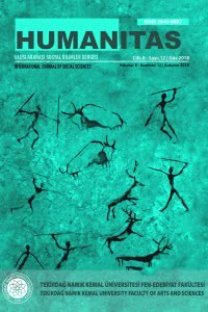Açlık Oyunlari Adlı Romandaki Yeni Kadın Kahramanın Monomitik Yolculuğu
Yazar Suzanne Collins’in romanı Açlık Oyunları’nın merkezindeki metaforda monomit yolculuğu bulunmaktadır. Bu araştırma, yazarın kahraman kavramını cinsiyet açısından yeniden tanımlamasına odaklanmış olup, aynı zamanda Collins’in monomitin yeniden anlatılmış versiyonunun günümüz dünyasındaki insan deneyimini temsil etmesine de değinmektedir. Bu çalışma, Collins’in başkahramanı olan Katniss’in başarıya giden yolda çok sayıda engel ve hayal kırıklığı ile yüzleşmesi konusuna değinilmektedir. Katniss kendi iç dünyasına dönmekte, feminen doğasını kucaklamakta ve kişiliğinin hem maskülen hem de feminen yanlarının entegrasyonu ve uzlaşısının sonucunda tatminkar bir hayatın arayışına girmekle birlikte, aynı zamanda hayattaki amacını da anlamakta ve gerçekleştirmektedir. Collins, romanda tersyüz ya da altüst edilmiş mitik ve arketipik durumları kabul etmekle birlikte, çağdaş toplumdaki özel ve genel başarıların önemini de yeniden ele almaktadır.
Anahtar Kelimeler:
monomit, yeni kadın kahraman, arketip, benliğe yolculuk, Açlık Oyunları
The Monomythic Journey of a New Heroine in the Hunger Games
Suzanne Collins’ novel The Hunger Games has as its central metaphor the traditional monomythic journey of the hero. This research focuses on the novelist’s attempt to redefine the concept of the hero in terms of gender, and also on the ways in which Collins’s retold version of monomyth represents human experience in the contemporary world. Collins offers an alternative to the paradigmatic hero’s journey, replacing it with the metaphor of the heroine’s journey. This study presents Collins’s protagonist, Katniss, who embarks on the traditional heroic quest -- which acquires a symbolical significance of a psychic experience -- and confronts multiple challenges and frustrations on her journey to success. During her heroic enterprise, Katniss turns inward, discovers and fully embraces her feminine nature and seeks a more satisfactory life paradigm as a result of which she attains the inner integration and reconciliation of both masculine and feminine aspects of her personality; she also understands and accomplishes her purpose in life. By recognizing the mythical and archetypal situations, which are subverted or inverted in the novel, Suzanne Collins reimagines the monomyth and also revises the significance and worth of private and public achievements in the contemporary community. Collins presents a new type of heroine who attains self-accomplishment only through her connection to the others.
Keywords:
monomyth, new heroine, archetype, journey to the self, The Hunger Games,
___
- Bolen, J. S. (2004). Goddesses in Everywoman, Powerful Archetypes in Women's Lives. New York: Harper Collins Publishers Inc.
- Collins, S. (2009). The Hunger Games. New York: Scholastic Press.
- Dubrofsky, R. E., & Ryalls, E. D. (2014). The Hunger Games: Performing Not-performing to Authenticate Femininity and Whiteness. Critical Studies in Media Communication, 31:5, s. 395-409.
- Frankel, V. E. (2010). From Girl to Goddess: The Heroine's Journey Through Myth and Legends. North Carolina: McFarland&Company, Inc.
- Kalshed, D. (1996). The Inner World of Trauma: Archetypal Defence of the Personal. London: Routledge.
- Leonard, L. (1982). The Wounded Woman: Healing the Father-Daughter Relationship. Ohio: Ohio University Press.
- Murdock, M. (2013). The Heroine's Journey. Boston: Shambala Publications, Inc.
- ISSN: 2147-088X
- Yayın Aralığı: Yılda 2 Sayı
- Başlangıç: 2013
- Yayıncı: Namık Kemal Üniversitesi
Sayıdaki Diğer Makaleler
Milliyetçi İsyanlar Bağlamında Arnavutluk’ta Komite ve Çetelerin Rolü
Açlık Oyunlari Adlı Romandaki Yeni Kadın Kahramanın Monomitik Yolculuğu
Metinlerarası Mizahın Bir Türü Olarak Anti-Atasözleri
Mary Elizabeth Braddon’un Lady Audley’nın Sırrı Başlıklı Romanında Feminist Çelişki
Bilişim Suçları Kapsamında Suça Sürüklenen Çocukların İncelenmesi
İhsan Oktay Anar’da Postmodern Bir Tercih Olarak Dilin, Yazım Kurallarına Aykırı Kullanımı
Dijital Emeğin Biyopolitikası: Heterotopya ve Mikropolitika Mümkün Mü?
Orta Ergenlik Dönemindeki Öğrencilerin Benlik Algılarının Mükemmeliyetçilik Düzeylerini Yordama Gücü
Bingül UZEL, Dinçer DÖNMEZ, Mustafa OTRAR
Ian Mcewan’ın Solar Romanında Küresel Felaketler ve Kişisel Tepkiler
